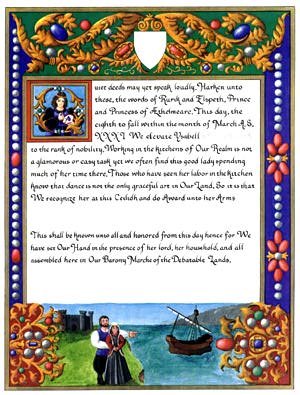Italian Renaissance style SCA scrolls.
This page has been provided as a teaching tool.
Feel free to come back here and visit often,
but please do not borrow or reuse the artwork without written permission.
All rights remain with the originators of the work.

The first two examples on this page were painted with gouache tube paints - on hot press watercolor paper.
paper size 11x14 inches
Illuminated area 9x12 inches
Text: Written in an Italic hand.
"Quiet deeds may yet speak loudly. Harken unto these the words of Rurik and Elspeth, Prince and Princess of Ęthelmearc. This day, the eighth to fall within the month of March AS XXXI, We elevate Ysabell Graveur to the rank of nobility. Working in the kitchens of Our Realm is not a glamourous or easy task, yet We often find this good lady spending much of her time there. Those who have seen her labor in the kitchen know that dance is not the only graceful art in Our Land. So it is that We recognize her at this Ceilidh and do Award unto her Arms:___________
This shall be known unto all and honored from this day hence, for We have set Our Hand in the presence of her lord, her household and all assembled here in Our Barony Marche of the Debatable Lands.
Calligraphy and illumination by
Lady Eibhlin ni Chaoimh

Text: written in an Italic hand.
By these words it shall be known to all, that this day, We, Rurik Prince by right of honorable combat, and Elspeth, our Princess and most glorious inspiration, have decreed Our most noble and gracious Jacopo di Nicollo, called "Jock" by some, is indeed worthy of recognition. No matter where he may be or whom he is with, he is always putting the interests of others ahead of his own. Be it making his pavillion available for others, fetching and carrying for a lady, cleaning dishes or sharing a story and a nip of Pussers, he can be counted on to do what needs done. For these and countless other services do We Award him Arms____________
As it is written so it is done this seventh day of December, AS XXXI in the presence of his Lady and his household at City of Ladies in Our incipient Shire of Beinn de na Preassan.
Calligraphy by Lord Aengus MacBain
Illumination by Lady Eibhlin ni Chaoimh

Text: written in 3 different hands (Roman, Humanistic & Italic Corsiva). Painted with gouache mixed with glair on hot press watercolor paper
GOOD PEOPLE ATTEND AND HEAR THESE WORDS
Of all the assets a Kingdom may boast, the skill and knowledge of her artisans is often highly praised
Such is the nature of the tidings that have ascended unto Our ear in compliment of _____. This loyal and noble lady has demonstrated such admirable workmanship in her basketry and command of period dyes that We, Christopher and Maurya, King and Queen of fair AEthelmearc see it as a fitting and proper acknowledgement of her talents to induct her into Our Order of the Sycamore. This We so decree before all assembled at this Tournament of the White Hart held this twenty sixth day of February Anno Societatis thirty-four in Our Shire of Port Oasis.
Calligraphy and Illumination by
THLady Eibhlin ni Chaoimh
 Chivalry scroll of Cygnus the Blissful,
Chivalry scroll of Cygnus the Blissful,
First Kinght of AEthelmearc,
Done on 14x18 inch vellum with mostly period materials.
Based on the Bible of Nicholas of Lyra (Florence, 1497)
Over 25 hours was spent on the gilding alone on this piece.
Main portrait: Yngvar & Caryl, first King & Queen of AEthelmearc Knighting Sir Cygnus as his wife Dorinda looks on. The frame for the painting is a gilded gold chain.
Portrait miniatures based on photos provided by Cygnus'wife,Dorinda (clockwise from upper left)Cygnus in armor, the badge of the populace of AEthelmearc, Cygnus, Dorinda, Cygnus and their son Quinn, Dorinda, The Arms of Cygnus surrounded by a white belt surmounted by a pair of gold spurs, Dorinda wearing a dress bearing Cygnus' Arms, Cygnus.
Calligraphy by Lord Aengus MacBain
Illumination by Lady Eibhlin ni Chaoimh
NOTES ON THIS STYLE
- There are several different late Italian Renaissance styles. Most of my Italian Renaissance scrolls are based on the work of Attavante.
- Limited choice of colors except in miniatures. Backgrounds of jewel toned red, blue and green.
- Acanthus vines most often painted in shades of a yellow ochre (orpiment or Naples yellow in period). There were other colors used for acanthus ... please check period exemplars for ideas.
- This is an example of the humanistic style. The goal is to capture reality on paper rather than imitate or represent it.
- Miniature portraits, heraldry, clusters of gemstones are prolific in borders
- Strings of gemstones (falling in lines or draped on leaves and other illuminations in the scroll) are very common.
- This style is more tedious than artistically demanding. Large miniature scenes can easily be replaced with more acanthus work. Clusters of gemstones substitute nicely and are often more appealing than the portrait miniatures so commonly found within the acanthus borders of period exemplars.
An article on how to do a basic Italian Renaissance layout can be found by clicking
* * * HERE.* * *




 Chivalry scroll of Cygnus the Blissful,
Chivalry scroll of Cygnus the Blissful, MAIN PAGE.
MAIN PAGE.